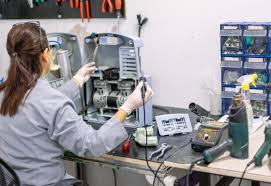UX design is emerging as a popular and satisfying career path for many students and professionals. With high entry-level salaries, work-life balance, and job satisfaction, it’s easy to see why it is becoming an important part of the tech design profession.
User experience (UX) designers are in demand across industries. The role typically falls under the larger category of web designers, which is expected to grow 23% (much faster than average) by 2030, according to the US Bureau of Labor Statistics.
There are many different paths to pursue a career in UX design. These include UX design boot camps, UX design bachelor’s degrees, self-study, certifications, and even a UX master’s degree.
A UX certification is one alternative that deserves consideration when pursuing a UX career path. The best UX design certification programs help students obtain a UX design education without a steep price tag.
What are UX design certification programs?
A UX certification is a credential that validates a person’s knowledge and expertise in the field of User Experience (UX) design. UX design refers to the process of creating meaningful and enjoyable experiences for users when interacting with a product or service, sometimes called interaction design. UX design and UX designers focus on understanding user needs, conducting user research, and designing intuitive interfaces that enhance user satisfaction.
A UX certification program doesn’t take nearly as much time to complete as a formal education. Also, your UX design certification is valid everywhere.
To obtain a UX certification, individuals typically undergo training or complete a certification program that covers various aspects of UX design and UX design skills. These include user research, design thinking, user-centered analysis, usability testing, and UX interaction design.
There are several UX certification programs available, either online or in person, that cater to different levels of expertise and focus on specific areas of UX design. Some certifications may focus on UX management. Others may emphasize practical usability testing or the UX design process.
10 UX certifications and bootcamp options
1. Google UX Design Professional Certificate
By completing the Google UX Design Professional Certificate, you can equip yourself with the job-ready skills you’ll need for an entry-level role in UX design. You learn at your own pace from professional UX designers at Google as you build a foundation in UX principles, best practices, research methods, and tools like Figma and Adobe XD.
Over multiple courses, you’ll have the opportunity to build a UX designer portfolio that includes high-fidelity mockups, case study reports, and interactive prototypes for three different projects. Upon completion, you can share your information with top employers hiring UX professionals.
- Who it’s for: Beginners with no prior UX design experience who want to learn from professionals at one of the world’s leading tech companies
- Length: Approximately nine months (six hours per week)
The School of UX
The London-based School of UX hosts a range of single-day classes and five-day intensives that can be broken down into day-long modules and taken at your own pace. Modules in the intensive program include UX Design, UI Design, Wireframing, Prototyping, and Career Advice. Each day includes a live question-and-answer session with a professional designer.
While courses are typically held in-person in London, everything has been moved to Zoom during the pandemic. Learners based abroad should consider the time zone difference, as everything is conducted live.
- Who it’s for: Beginners who want a crash course in UX design followed by personalized mentoring
- Length: Five days (flexibly spaced)
Interaction Design Foundation
The Interaction Design Foundation (IDF) is one of the world’s biggest online design schools. It offers a variety of online courses and boot camps for those looking to transition to a UX career. You can choose from six- to nine-week boot camps in topics like UX Fundamentals, Introduction to Design Thinking, or Get a New Job in UX Design. Each includes one-on-one coaching, guided project work, and the chance to build a portfolio.
If you’re looking to develop specific skills, IDF also offers self-paced courses in topics like usability, data visualization, and human-computer interaction. It also offers accessibility design, and designing for augmented and virtual reality. Each course comes with a certificate of completion.
- Who it’s for: Beginners and professionals who want several course options when building their UX design training
- Length: Six to nine weeks for boot camps (40 hours per week); 15 to 18 hours per course
Springboard UX Career Track
The Springboard UX Career Track is built for career changers seeking a direct route into the field and for those who can demonstrate some relevant knowledge or experience.
Prerequisites for the course include an aptitude for problem-solving, communication, and collaboration, together with at least one year of documented professional experience (or a degree) in a related field—such as graphic or visual design, psychology, research, marketing, or web development.
- Length: 6 months (15-20 hours per week)
HFI Certified Usability or User Experience Analyst
You can achieve two levels of certification from Human Factors International (HFI): Certified Usability Analyst (CUA) for those new to the career, or Certified User Experience Analyst (CXA) for more advanced UX professionals who have already passed the CUA. Both require taking four courses held over 10 days, with both in-person and online options.
Active UX consultants teach the courses, which include interactive individual and group exercises, exercise books, and study guides.
- Who it’s for: Beginners seeking entry-level knowledge or professionals who want advanced training
- Length: 10 days for training, 2.5 hours for exam
Nielsen Norman Group UX Certification
The Nielsen Norman Group holds various UX conferences in different cities around the world. Each conference offers a different combination of courses, and in order to get the UX design certification, you’ll need to attend five of these courses.
Once you’ve attended five courses and passed the online exam for each course, you’ll receive your certificate. You can take all five courses and exams at a single UX conference, or accumulate your credits at different conferences.
To obtain the Nielsen Norman Group UX design certification, you are required to attend five full days (or courses) and to sit an exam for each course, with each exam lasting one hour. You will have access to the exams for up to 35 days after each in-person course, so the program can be completed at a relatively flexible pace.
- Length: 5 full days accumulated over any time period
Bentley University UX Certificate Program
Several universities have started offering graduate certificates in UX, and Bentley University runs one of the most well-established programs. Earning a certificate means completing nine courses: three required courses (Human Factors and the User Experience, Usability Testing, Managing a User Experience Group) and six other courses of your choosing.
Each course is held online or in person over two days, followed by a portfolio assignment that you’ll have two weeks to complete. Courses take place from 9am to 5pm on Thursdays and Fridays—something to consider if you’re working or have other scheduling obligations.
- Who it’s for: Beginners and professionals who want the backing of a respected university certification program
- Length: Nine two-day sessions plus 45 to 63 hours to complete assignments (five to seven hours per course) completed in as little as one year
NN/g UX Certification
Become UX Certified by taking any five courses and passing subsequent exams from the Nielsen Norman Group (NN/g), which was founded by Don Norman (who coined the term “user experience” while working at Apple) and Jakob Nielsen. What’s more, you can design your own curriculum by choosing from over 50 courses, so you can select the courses that are most beneficial to your learning needs.
Advanced certification options include Specialty Recognition (pass at least five courses in a single specialty area) and UX Master Certification (complete 15 courses).
- Who it’s for: Beginners interested in UX design fundamentals and professionals seeking advanced certification options
- Length: 30+ days
CareerFoundry UX Design Program
The CareerFoundry UX Design Program is ideal for anyone who wants to become a fully-fledged, job-ready UX designer. The curriculum has been built for beginners, so you don’t need any prior knowledge or experience in the field.
What’s more, the course is flexibly paced and taught entirely online, making it a feasible option if you need to fit your studies around other commitments.
- Length: Between 5 and 10 months, flexibly paced
General Assembly UX Design Immersive
General Assembly offers a beginner-friendly, full-time boot camp online. There’s no exam, so you’ll get a signed certificate of completion for finishing the course.
Throughout the 12-week program, you’ll cover a broad range of interface and visual design topics through live lectures, one-on-one instructor check-ins, project toolkits, and interactive collaboration. At the end of the course, you’ll team up with other students to complete a capstone project throughout a three-week sprint. You’ll also spend time preparing for a job search. The course includes resume reviews, interview prep, and whiteboarding practice.
- Who it’s for: Career changers who want a concentrated, immersive training experience without the pressure of an exam
- Length: Full-time for 12 weeks
Designlab’s UX Academy
Designlab’s UX Academy is geared towards both experienced and novice designers who want to forge a career in UX.
Similar to the programs offered by CareerFoundry and Springboard, the Designlab course focuses on getting you job-ready, so it’s one of the better options for those looking to make a complete career change.
The UX Academy Journey is divided into three stages. The first step, Design 101, takes 4 weeks to complete (at a pace of 10-15 hours per week) and serves as a foundation course to prepare you for the main curriculum. At this stage, students are paired with an expert mentor.
If the work you complete as part of Design 101 meets the admissions requirements, you’ll proceed to the main UX Academy. Together with your mentor, you’ll work on a range of projects and exercises over 15 weeks full-time or 28 weeks part-time. The final step focuses on polishing up your portfolio and searching for a job.
- Length: 4-12 months
Benefits of UX design certification programs
A UX certification can benefit individuals pursuing a UX career in several ways. Firstly, it demonstrates a commitment to professional growth and competence in the field. Secondly, a certification program can enhance job prospects and provide a competitive edge when applying for UX design positions.
It also helps solidify the understanding of UX design principles and provides a framework for approaching UI design (User Interface design), which focuses on the visual aspects of the user experience.
Overall, a UX design certification program is a valuable asset for individuals looking to establish themselves in a UX career. It provides a recognized credential, validates UX design skills, and equips professionals with the necessary knowledge to create compelling UX design concepts.
Recommended Articles
- How to Become a Notary Public in Georgia: 2024 Guide
- How Does Salary Work? A Complete Guide
- Computer Engineer Salary: How Much Do Computer Engineers Make?
- 15 Jobs That Pay $50 An Hour And Above in 2024
- Best-Paying Trade School Careers for 2024
- How Does Salary Work? A Complete Guide






